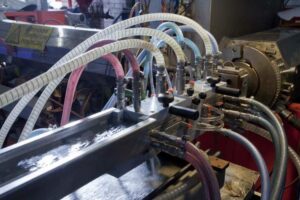The selection of materials is crucial in product development to ensure optimal performance and durability. The plastic extrusion process is fundamental in manufacturing plastic profiles and gaskets, offering tailored solutions for various industries. This article delves into the extrusion process, explaining what plastic extrusion entails, the materials that can be processed, the stages of extrusion, and the different applicable methods. Finally, we will discuss how to choose the most suitable method for your needs.
What is plastic extrusion?
Plastic extrusion is a manufacturing process that involves continuously heating and melting plastic material, directing it through a specially designed die, and subsequently cooling it to obtain a profile with a defined shape. In simple terms, it transforms raw plastic into plastic profiles through a continuous and controlled process, allowing for products with high dimensional precision and consistent quality.
Which plastic materials can be extruded?
Various types of rigid and flexible plastics can be processed through extrusion, including:
- PVC (polyvinyl chloride)
- ABS (acrylonitrile butadiene styrene)
- Polycarbonate (PC)
- Polypropylene (PP)
- Polyethylene (PE)
- TPE (thermoplastic elastomers)
- PMMA (polymethyl methacrylate)
- ASA
- SAN
- Engineering polymers and other specialized polymers
These materials can be used to produce both plastic profiles and gaskets, with applications ranging from construction to automotive, refrigeration to industrial plants, furniture to lighting, plumbing to household appliances.
What are the stages of the plastic extrusion process?
The plastic extrusion process comprises several fundamental stages:
- FeedingThe plastic material, usually in the form of granules or powders, is fed into the hopper using vacuum loaders or dosing systems.
- Melting and mixingThe plastic moves from the hopper to a rotating screw within a heated barrel. Here, due to heat and frictional forces, the material melts and becomes homogenized.
- Profile formationThe molten plastic is pushed through a die designed to achieve the desired geometric shape. In coextrusion, different materials are combined simultaneously to create a composite profile.
- Cooling and calibrationAfter exiting the die, the profile is cooled by passing through water tanks or air tunnels, stabilizing its shape and dimensions.
- Downstream and finishingThe cooled profile undergoes further processing, such as cutting to length, drilling or punching if necessary, and customization operations like printing or applying films or adhesive tapes.
Types of plastic extrusion
There are various types of plastic extruders, each with its own characteristics:
- Single-screw extrusionPrimarily used for standard applications where a single material is extruded to form plastic profiles.
- Twin-screw extrusionAllows for better material mixing and is employed for polymers requiring precise control of temperature and viscosity.
- CoextrusionAn advanced process that uses two or more extruders to combine different materials. Ideal for creating products with multifunctional properties, such as profiles that combine rigidity and flexibility or that blend recycled materials with virgin ones. Coextrusion is often used for applications requiring highly customized plastic profiles and gaskets.
How to choose the most suitable extrusion method
The choice of plastic extrusion process depends on various factors:
- Type of materialThe composition and thermal characteristics of the polymer influence the choice between single-screw, twin-screw, or coextrusion.
- Final applicationComponents subjected to high thermal stress or extreme environmental conditions require extrusion processes that ensure greater resistance and stability.
- Product customizationFor tailored solutions, such as plastic profiles with specific material or color combinations, coextrusion offers greater design flexibility.
- Production costs and timesProcess efficiency and material cost are determining factors in choosing the most suitable extrusion method.
Conclusions on plastic extrusion
The plastic extrusion process is fundamental for producing high-quality plastic profiles and gaskets, offering numerous advantages in terms of customization, efficiency, and versatility. Thanks to our advanced extrusion and coextrusion processes, we can create tailored solutions that meet the specific needs of our clients.
Request a quote now
Fill out the form on our website to receive a personalized offer or consultation. Discover how we can help you transform your ideas into reality and obtain the plastic profiles and gaskets best suited to your needs.


